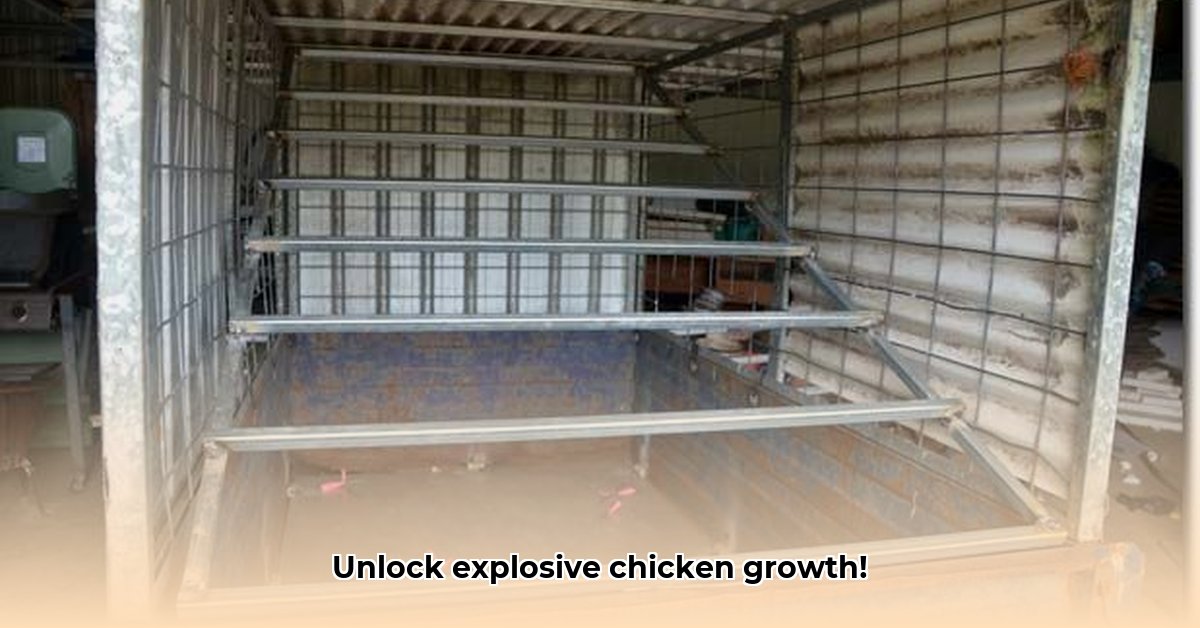
Chicken Tractor on Steroids: Supercharging Your Chicken-Keeping and Crop Yields
This guide details how to build a highly productive chicken tractor composting system – a "chicken tractor on steroids" – for maximizing yields. We'll cover building the tractor, maximizing compost, and optimizing crop production. This system transforms chicken manure into nutrient-rich compost, minimizing the need for external fertilizers. For pre-built options, check out these chicken tractor kits.
What is a "Chicken Tractor on Steroids"?
The term "chicken tractor on steroids" refers to significantly enhancing a traditional mobile chicken coop's efficiency. It’s a system where chicken waste becomes highly effective compost, fostering a thriving, self-sustaining ecosystem of healthy chickens, fresh eggs, and bountiful crops. It represents sustainable farming with a considerable productivity boost.
Two Models: Backyard Bliss vs. Farm-Scale Frenzy
We'll explore two models: a small-scale backyard system and a larger-scale commercial operation. Both leverage composting, but differ in size, setup, and management.
Model 1: The Backyard Booster – Small-Scale Chicken Power
This model suits small yards or urban settings. A roughly 16-square-meter area, divided into sections, allows your flock to move, their droppings acting as natural fertilizer. Composting occurs in situ, simplifying management.
Building Your Backyard Booster: A Step-by-Step Guide
- Design and Build: Construct a movable enclosure (e.g., from pallets or plywood), divided into 2-3 sections for rotation. Ensure it's secure, yet spacious for your chickens.
- Layering the Compost: Begin with bedding (wood shavings or straw). As chickens use the area, add more bedding, mixing it with the manure. Turn this mixture every 3-5 days for aeration and optimal decomposition.
- Strategic Relocation: Move the tractor to a fresh section every few days. This allows previous areas to rest, and compost to break down before planting.
- Planting Time: After a suitable rest period (climate-dependent), the area is ready for planting. The chicken manure compost promotes healthier, more productive plants.
Model 2: The Commercial Powerhouse – Scaling Up for Serious Yields
This model is for larger operations (0.5-1 acre or more), requiring a complex setup and management for significantly increased yields. Imagine a highly efficient, continuous composting system integrated directly into your poultry operation.
Key Considerations for Large-Scale Systems:
- Infrastructure: Robust structures, possibly with conveyor systems, are needed for efficient chicken tractor movement and waste management. This accelerates composting and maintains hygiene.
- Advanced Compost Management: Larger-scale composting necessitates techniques to control temperature and airflow. Mechanized turning systems might be necessary for even decomposition and preventing anaerobic conditions (lack of oxygen).
- Scalability Planning: Careful planning optimizes resources, minimizes environmental impact, and accommodates operation growth. This might include waste processing and expansion considerations.
Comparing the Two Models: A Quick Glance
| Feature | Small-Scale (Backyard Booster) | Large-Scale (Commercial Powerhouse) |
|---|---|---|
| Area Covered | 16 sq m | 0.5-1 acre |
| Management Effort | Relatively low | High |
| Initial Investment | Low | High |
| Potential Yield | High for its size | Significantly higher |
| Labor Intensity | Low | High |
Challenges and Considerations
Successful "chicken tractor on steroids" systems require proper composting to prevent harmful pathogens. Maintaining high compost temperatures eliminates disease-causing organisms. Vigilance is needed to address potential disease outbreaks, as with any poultry operation. Further research on economic viability and long-term sustainability is needed.
How to Optimize Chicken Tractor Composting for Maximum Crop Yields
Key Takeaways:
- Effective chicken tractor management significantly boosts soil fertility and crop yields.
- Strategic placement and regular movement prevent soil compaction and nutrient depletion.
- Careful composting maximizes nutrient recycling within the tractor
- Understanding chicken breeds and integrating them with your composting strategy significantly improves efficiency.
- Regular monitoring and adjustment are critical for success.
Supercharging Your Soil: The Chicken Tractor Approach
A chicken tractor is a mobile fertilizer factory, a portable coop creating fertile ground. It's a dynamic composting system integrated with your gardening. Optimizing its power for maximum crop yields is key.
Building the Ultimate Composting Chicken Tractor
This isn't an average chicken coop; it's a system optimizing chicken welfare and compost generation.
1. Coop Design: Build a sturdy, movable structure. Consider using materials that decompose, adding to the compost. Size depends on flock size; ensure adequate space.
2. Run Design: The area around the coop is crucial. Make it large enough for chickens to scratch and evenly distribute manure without overgrazing. Consider wire mesh to avoid soil compaction.
3. Rotational Grazing: Move your tractor every 3-7 days (depending on flock size, soil type, and vegetation). Observe for overgrazing and adjust frequency accordingly.
4. Compost Management: Implement focused composting techniques within the run (designated areas or removable bins). Ensure aeration by turning the compost (every 3-5 days). Add brown materials (straw, wood chips) to balance moisture.
5. Chicken Breed Selection: Research breeds known for efficient manure production and foraging habits to optimize compost nutrient content.
Maximizing Nutrient Cycling
Chicken manure is a valuable resource. Efficient breakdown into rich compost is essential.
- Monitor Moisture: Keep compost consistently moist, but not soggy.
- Carbon-Nitrogen Balance: Add "brown" (sawdust, straw) to balance "green" (manure).
- Regular Turning: Turn the compost at least three times weekly for aeration.
- Soil Testing: Regular testing helps understand the chicken tractor's impact and fine-tune your moving schedule.
Addressing Potential Challenges
While chicken tractors offer advantages, potential challenges include soil compaction (if not properly managed), pest/disease issues (if not well-maintained), regular movement requirements, and initial investment. However, the benefits—increased soil fertility, reduced pest pressure, natural fertilization, reduced feed costs, and healthier chickens—generally outweigh the drawbacks.